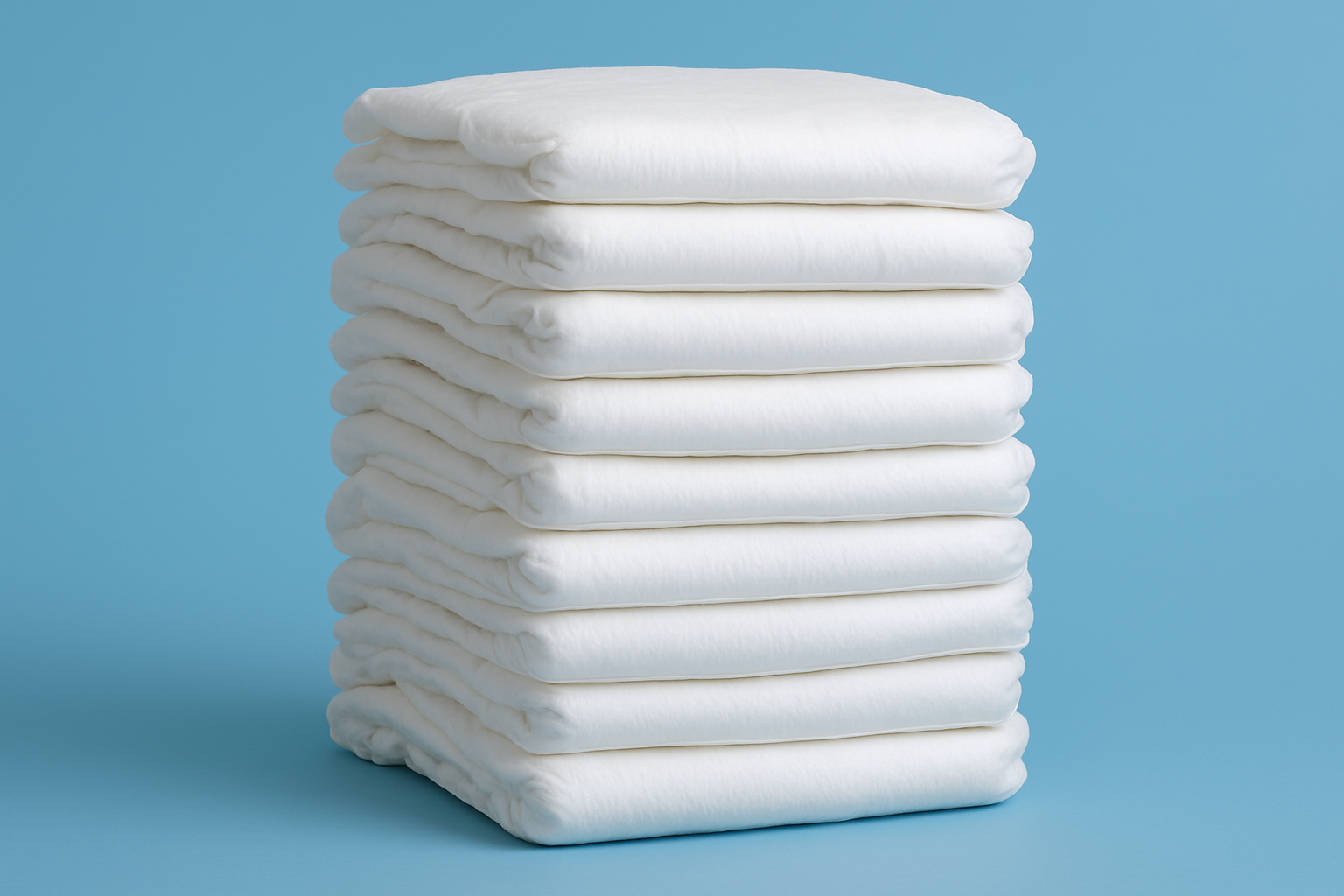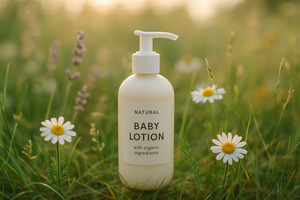365 Diapers (Whole Foods) are ECF, and free of fragrance, latex, and TBT. We are also calling them Sneaky Stuff because of their lack of disclosure about phthalates, dyes, and lotion.
Price per diaper: $0.24
Earth’s Best Tendercare Diapers At first glance these diapers appear to be at least Good Stuff: they use a “plant based plastic” for their top-sheet and back-sheet and a cellulose fluff/SAP/bio-SAP core. However, there is no info on whether Earth’s Best diapers are phthalate-free or lotion-free. They do claim to be dye-free, but don’t give any info on what is used for the print. There is a general absence of transparency about the composition and percentage of the diaper that uses “plant-based plastic.”
Price per diaper: $0.32
Huggies Diapers are ECF, and free of fragrance, lotion, latex and parabens. The label states that they are “EU 26 allergens free,” as well. I’m not moving them from Sneaky Stuff because they do not disclose any information about phthalates, dyes, or the composition of the back-sheet.
Price per diaper: $0.59 to $0.88
Kirkland Signature Diapers As many of you know, Kirkland has made some great improvements to their diaper, and now appear to be free of latex, chlorine, fragrance, lotion, and artificial dyes. That said, there is no evidence that they are free of phthalates (we chatted with a rep and they said that they were unable to provide an answer about phthalates) and of course they are still made of petroleum-based plastics. They state that “some of the polyethylene is made from sugar cane” I would like say they’ve upgraded from Bad Stuff to Okay Stuff, but with a lable that boldly claims that these diapers are “made with plant-based materials,” coupled with the lack of transparency on phthalates, we have to call these green-washed, and therefore Sneaky Stuff.
Price per diaper: $0.26
Mamma Bear (Amazon brand) are ECF, fragrance free, latex free and hypoallergenic, but have no further information available. Mama Bear gets a “Sneaky Stuff” designation for lack of disclosure about phthalates, dyes, and lotion.
Price per diaper: $0.16
Rascal & Friends Premium Diapers A few of you asked about this brand, but the response we received was: “Unfortunately, we are unable to provide a detailed ingredients list of our diapers, as this is commercially sensitive. We are proud to say that our products are free from formaldehyde, elemental chlorine, phthalates, parabens, gluten, and endocrine disruptors. We also have a focus on no nasties, and our diapers contain no latex or fragrances and we only use water-based inks! The inks we use are non-toxic and completely harmless to baby’s skin.” Without more details on what is in these diapers, we will consider them Sneaky Stuff.
Price per diaper: $0.22
Up & Up Diapers (Target) are Sneaky Stuff because the label states “petroleum-free lotion” and “perfume-free” as opposed to simply being lotion-free and fragrance-free, although we did confirm that they do not contain phthalates.
Price per diaper: $0.43







































268 comments
Lia G.
I have also been reading a lot of good things about Bambo diapers, but one site I really trust mentioned the fact that these diapers use chlorine dioxide (non-elemental) bleach, and as such, recommended Honest and Naty diapers over Bambo. I’m a bit confused!
Maia James
I don’t know this brand, but can add to my list for a future investigation!
Maia James
I haven’t checked out this brand just yet, but it’s on our list to research. :)
Angela
I’m having a baby next month and am curious if you’ve had a chance to review Parasol Co. diapers further? Your site and reviews have been invaluable to me and would love to hear what you think as they are new on the market! Thanks so much.
Katelyn
Also just came across this article that compared 24 diaper brands, many of the ones people have been asking about are in here. Thought this was super helpful (although they don’t have beaming baby which I’m very curious about!)
http://m.babygearlab.com/Disposable-Diaper-Reviews
Katelyn
When I googled biodegradable diapers, “beaming baby” came up. Looks like they are from the UK and seem to have good reviews in the UK. Do you know anything about them? They seem to be a little more affordable than bambo. Choosing a diaper has put me at my breaking point. Ahhh
Sinei Botana Walker
Have you checked out Parasol diapers? What do you think?
Maia James
I don’t know this brand, but I will definitely add to our list to investigate!
Asmira
Hi Maia,
What do you know about the ALDI brand “Little Journey” diapers and wipes? Could they be good stuff?
Thanks much
Maia James
I am sorry but I am not familiar with the brands you mentioned.
Hina
Hi, as told in the bad stuff that pampers n huggies are not good then what should b used here in ksa? Here the products u r telling are not available. What to do? Here v have Bambi bu sanita, babyjoy other than pampers n huggies. Plz reply soon as i neef to buy. Thanks
Samantha McGinnis
I went looking for a new brand of diapers for my daughter a few months ago, and after reading this guide, I decided to give Bambo diapers a try. They are absolutely AMAZING! Her diaper rash issues have cleared up, they fit really well, and they are honestly the best diapers I have ever used. I don’t think I could ever go back to my old brand now. Thank you so much for the recommendation! I absolutely love this site and check the guides quite frequently when I’m out shopping.
Maia James
I honestly don’t know the answer to this, and no longer have children in diapers—hallelujah! Ours always went in the trash, and that’s what everyone I know does with diapers, too. I hope a NYC reader will pipe in here with some info about composting diapers!
Danielle
Just looking to find if there is more than the two brands that are okay to use.
Maia James
It’s on our list for an update, but I don’t have a definite date. If there is a specific brand you’re wondering about, feel free to ask here!
Nathaniel Crocker
Hi, I am very curious about your comment on recycling your disposables. Because you live in NYC do you have a special recycling facility for diapers? It is my understanding that in the US, human waste is considered a bio hazard because of the potential pathogens. It is illegal to throw in the trash or to compost.
There is a company Knowwaste, based in NYC
http://www.cmconsultinginc.com/wp-content/uploads/2011/03/Diaper-recycling.pdf
That has developed after 15 years of research a way to safely recycle diapers. It’s amazing technology that I hope because widespread.
It’s my understanding that unless you have a specified composter that is equipped to sterilizethe pathogens, you can’t simply put a baby diaper in a city composting service. I am only aware of few cities in the world that have this service.
Danielle
When will you be updating on all the brand that people have listed in the comments? I’m very curious about a few still and hoping you will soon because baby comes end of December beginning of January and I just want some disposables for the hospital.
Thank you
Maia James
I’m sorry, but I don’t know this brand. I will look into it!
Lauren
Any thoughts on nurtured by nature? Widely available on Amazon and work really well without being crazy expensive.
Mr Spencer Larkin
Dear Sir /Madam,
My Name is (Mr Spencer Larkin) An a Program Associate person in United States Of America.Our Non Governmental Charity Organization here United States Of America want to buy your BABY DIAPERS in very Large Quantity for charity distribution to some Motherless Babies Homes all over the world.
If your interested and can supply the product respond back to me here at email:spencerlarkin73@gmail.com for further communication.
Mr Spencer Larkin
Kiva Organization USA
Program Associate,Kiva Zip person.
Website: www.kiva.org
Email: spencerlarkin73@gmail.com
Telephone: 1 512 8230 315
Migle Swies
Yes please! I am interested too. Used on my kids since birth. And still using the wipes. I hope they end up healthy :/
Maia James
Oh, there are many! Here’s a recent one: https://www.washingtonpost.com/opinions/why-cloth-diapers-might-not-be-the-greener-choice-after-all/2015/05/08/32b2d8dc-f43a-11e4-bcc4-e8141e5eb0c9_story.html
Maia James
Yes, I think Honest would be the next best option;).
Audrey
Hi! do you have the info on the study that you cite about disposable diapers using more energy, water, etc than cloth diapers. I would love to see it. Many thanks! Very helpful blog all around.
Ferry
I’m surprised that Earth’s best is in the sneaky stuff. Another website mentions that it is the best “natural”, eco and budget friendly option out there. They also mentioned that Bamboo was the best of them all but budget-wise, it is too costly for us. I would have gone with cloth diaper but living in an apartment building with only one washing machine in the basement makes it tricky. Which disposable brand (budget friendly) would you recommend? I was considering the Honest co. Diapers.
Maia James
Hi Laura! We’re still making our way through our research list for this guide. There will be an update soon.
Laura
Hi!
I saw that you previously hadn’t looked into Parasol diapers, but wondering if you’ve since found any additional information….
Thanks :)
Sherry
I saw another person ask about the Delora Diapers. I too am interested what you think of them.
https://www.bbbuggy.com/store/Delora-Eco-Nappy-Disposable-Diapers-8818.htm
Apparently they are two thirds biodegradable/compostable with the balance described as ‘earth neutral’. The soft, white outer cover is made from organic (GMO free) plant starch and is 100% biodegradable and breathable. The cellulose in the core of the diaper is derived from certified renewable forestry. They are not chlorine bleached. Dermatologically certified as ‘especially skin friendly’ which makes them ideal for babies with eczema, chronic diaper rash or sensitive skin. They come packed in 100% biodegradable/compostable foil bags.
Fragrance, latex, TBT, dye and chlorine-free
Michelle
Ok thanks! I can’t wait to hear when you rate them! I’m just trying to find a diaper that is good but not very expensive.
Maia James
I consider Earth’s Best to be Sneaky Stuff. I haven’t reviewed BabyGanics yet, but will when we update the guide!
Michelle
Wondering if babyganics or earth’s best diapers are any good?
Maia James
I don’t know that one, but will add to the list for the updated guide!
Carly
What about Delora?
Maia James
They are on the list to research:).
Natasha
What would you say about the new company diapers from Parasol Co.???
Maia James
Hi! I haven’t had a chance to drill down on the diaper ingredients, but I’m not wild about what’s in their wipes (phenoxyethanol among a few others)…I would call them Okay Stuff:)
Deanna
What is your opinion on the new company that just launched called Parasol Co? They have diapers and wipes. They launched just a few weeks ago.
Melissa Masters
I’ve used them and didn’t have any issues but I didn’t find them much cheaper than bambo. Honestly I think you have to just try them on your baby. Like I said earlier, I love bambo but others complain that they leak. Some just work better on certain kids. Good luck
Melissa Masters
Look under the bad tab…pampers, huggies, luvs. all = bad
Melissa Masters
I actually saw those reviews the other day and was really surprised to read such negative feedback. My 6 month old is currently in a size 3 of bambo and I love them! They do run bigger but I just Make sure to pull them up snug towards his belly button and Velcro below the design. As far as leaks, no issues unless I don’t change him In The middle of the night and that’s just because he pees like crazy lol. He definitely pees more than my other ones did but these diapers have really held up well. My husband even remarked the other day that he was surprised by how well they worked(he doubted a natural diaper would be effective). My Don actually woke up yesterday morning with the fullest diaper ever, accompanied by a stinky surprise :-0 which could have Been a disaster for his new burts bees sheets(soft and perfect FYI) and I would have been devastated lol. Thankfully that crisis was avoided and now I love his bambo diapers even more!
I say give them a try and see how they work for you. Can’t always go by review’s, for example I tried life factory glass bottles because of the stellar reviews and I was highly disappointed! The neck is way to small and my son gulps way too much air. Joovy boob glass bottles are my recommendation if anyone’s curious. oh and I also use the Jackson Reece herbal wipes now thanks to you Maia ;-) and couldn’t be happier with them!
Maia James
Hi Tina-
Kirkland are conventional diapers, so they aren’t Good Stuff, unfortunately.
Tina
What about kirkland brand diapers? Where do they rank?
Cecilia
I am very curious about anyones experience with Honest Company diapers, as I’ve read ALOT of reviews stating that they leak and blow out often. I’ve read up on earths best, seventh generation, and babyganics and what I’ve found is that they hold up way better than them. I do like Honest for not using as many ingredients and being a bit safer than the other brands, but I dont like hearing that their diapers suck. (I do buy their other products though). Just wanted to see if someone could share their experience. Thanks!
Maia James
Thank you! I do need to update this page, because now in my Brooklyn neighborhood we have compost bins outside of our apartment, so we now compost!
Jen
I also live in NYC and am wondering if you are aware that you can drop off compostable matter at your local Greenmarket. I don’t know if every NYC greenmarket offers this, but every one that I have checked (four different locations in Manhattan) does.
http://www.grownyc.org/compost
According to the website, they do not accept all compostable matter, but every greenmarket compost volunteer I’ve spoken to says that certain banned waste, meat scraps for instance, are okay so long as they make up a small proportion of the compost you bring. My guess is they will not accept a bag full of compostable diapers, but maybe they can accept one or two in a grocery bag full of the okay stuff, e.g., fruit and veggie scraps. Of course, babies use up A LOT more than 1-2 diapers per week!
Another thing – even the “best” disposable diapers, Bambo according to your website, won’t biodegrade properly in a normal landfill even if they are made with all or mostly all biodegradable materials. Landfills are too tightly packed for things to break down so these biodegradable diapers will be around just as long as the regular diapers, sadly.
Maia James
For that I like the Honest reusable one:
http://goo.gl/R9BT1H
Bonnie Denham
Do you have a recommendation for safe swim diapers?
nilam
tell me that pamper is good or bad diaper
Maia James
Will add to our list for review when we update this guide!
FTM
What about Aleva Naturals Bamboo Baby diapers? Your site is so helpful, thanks!